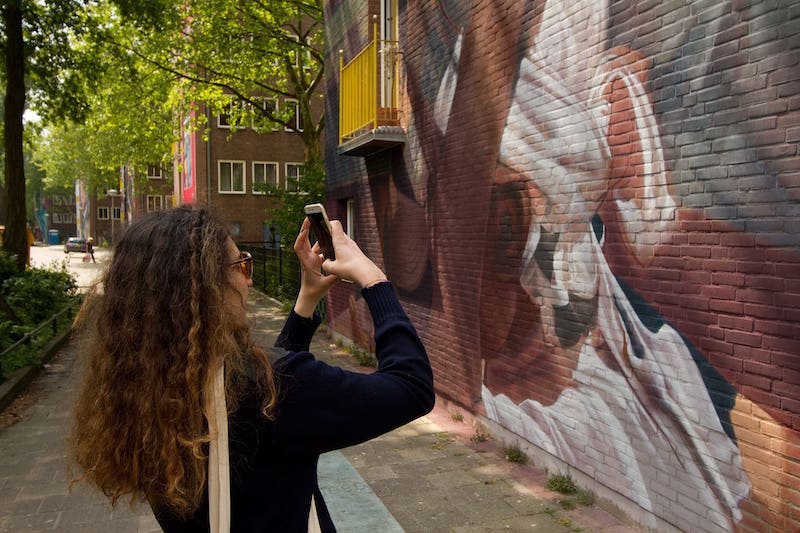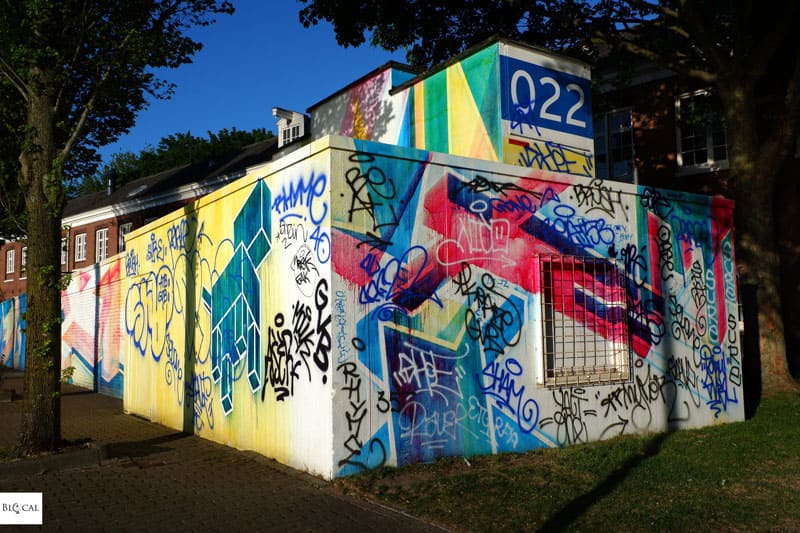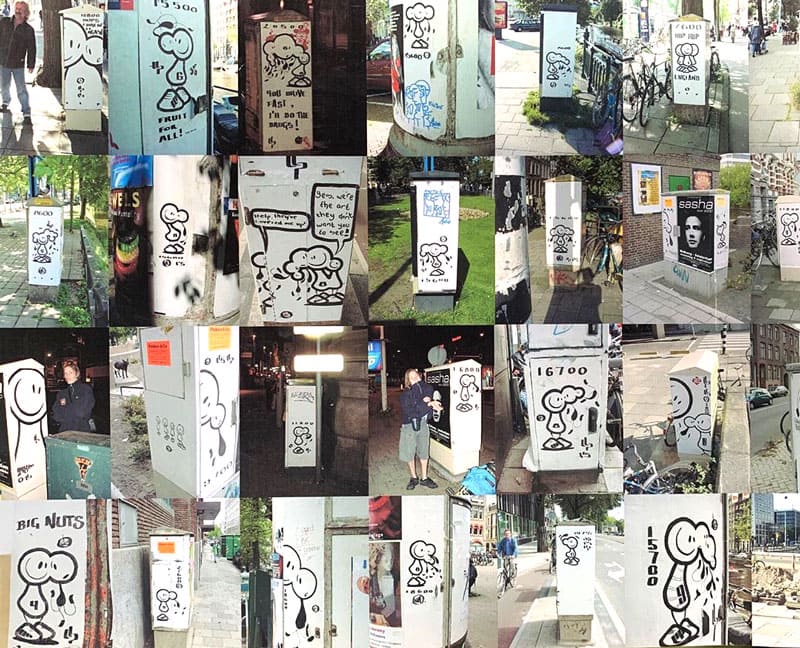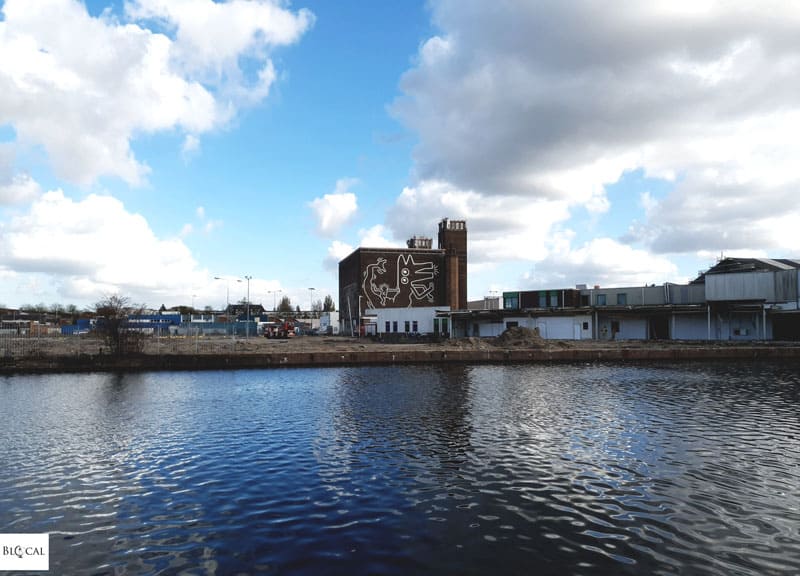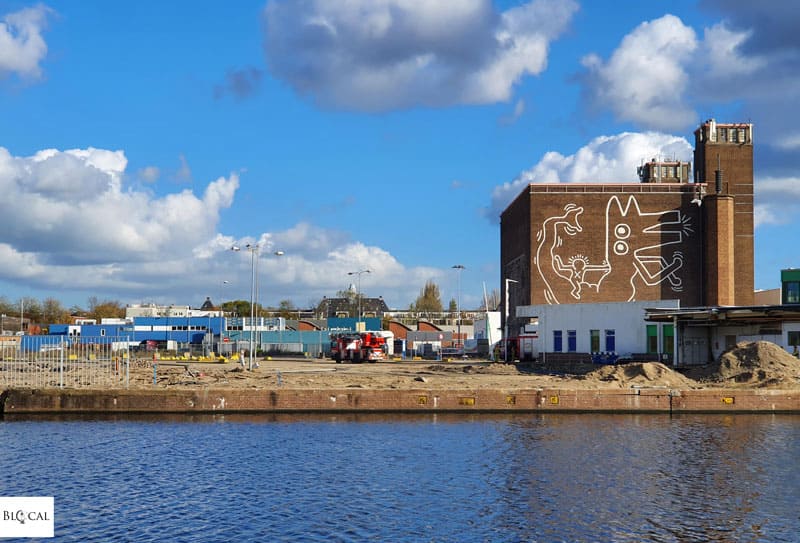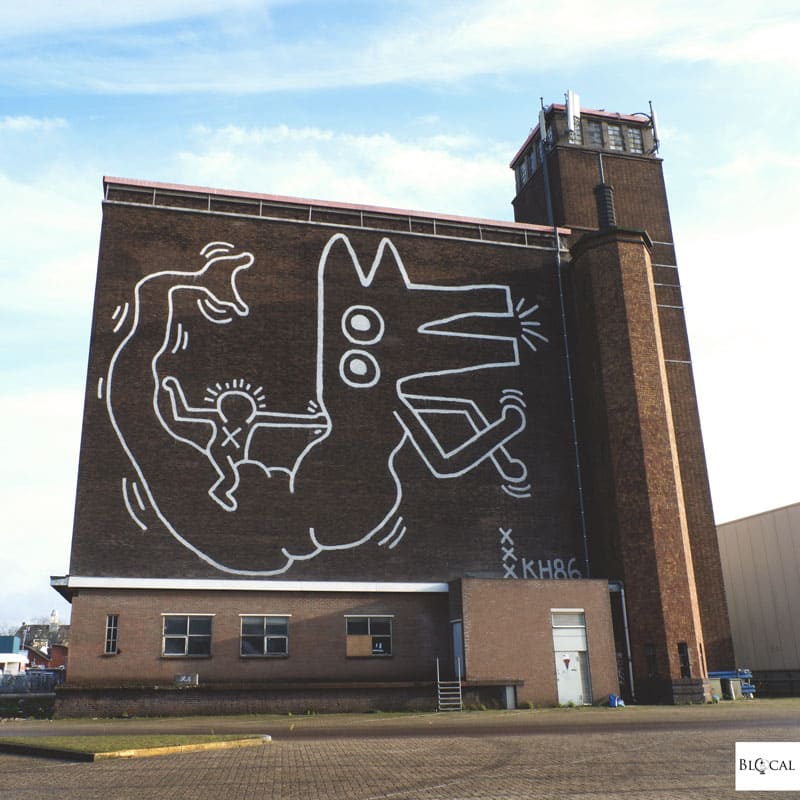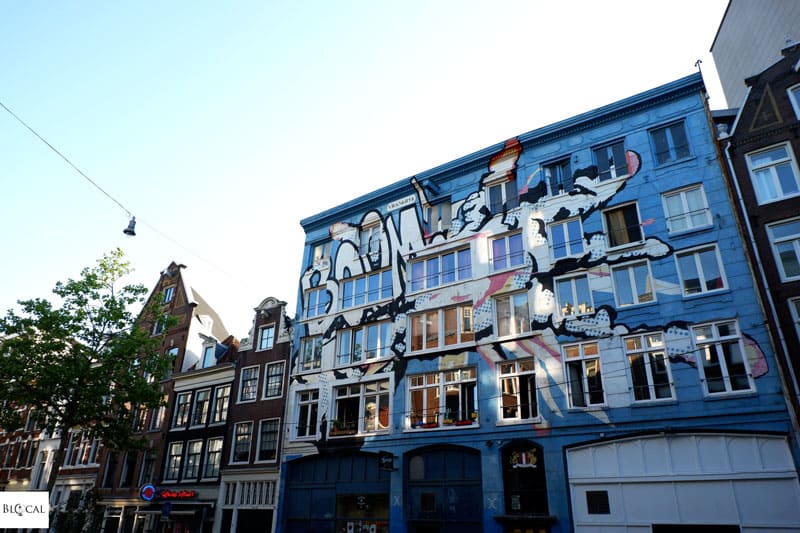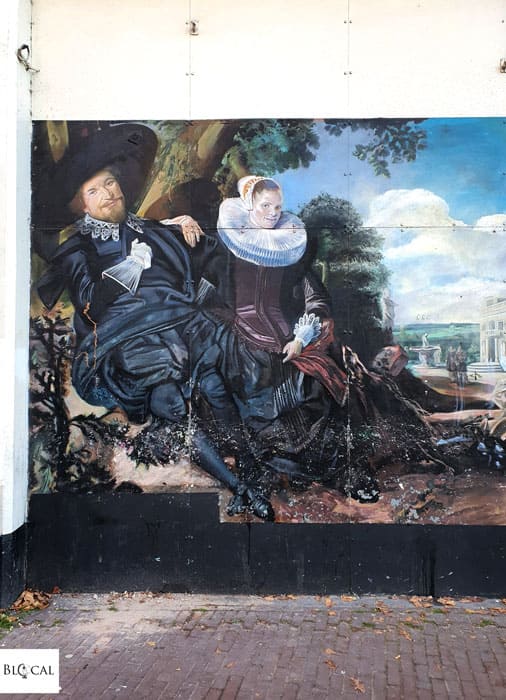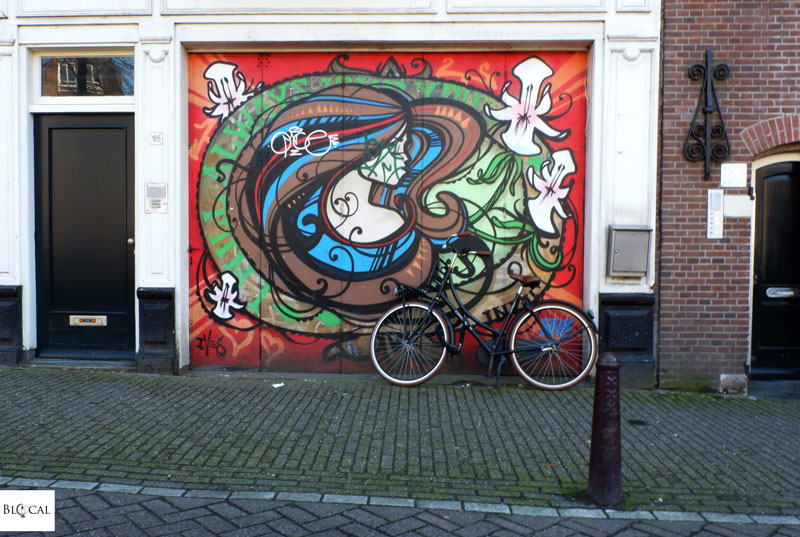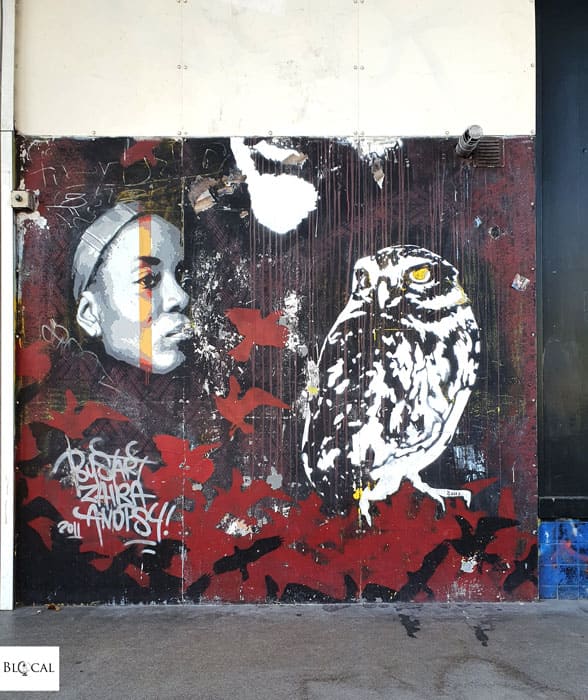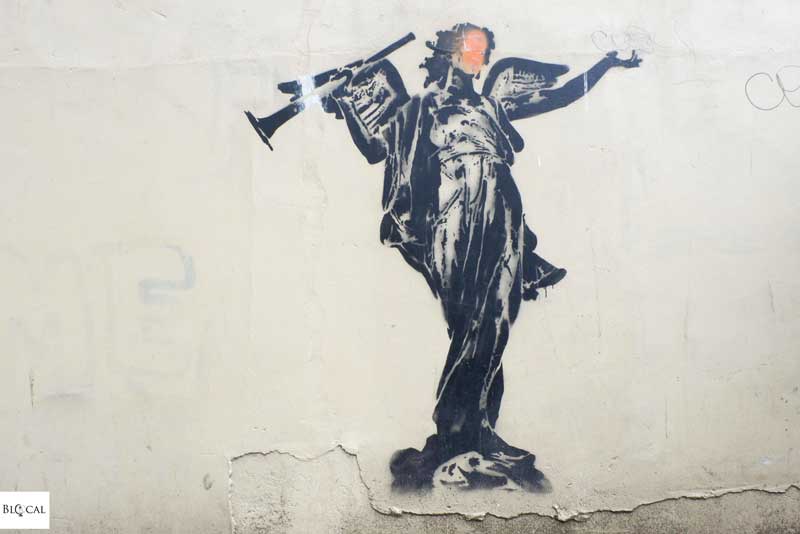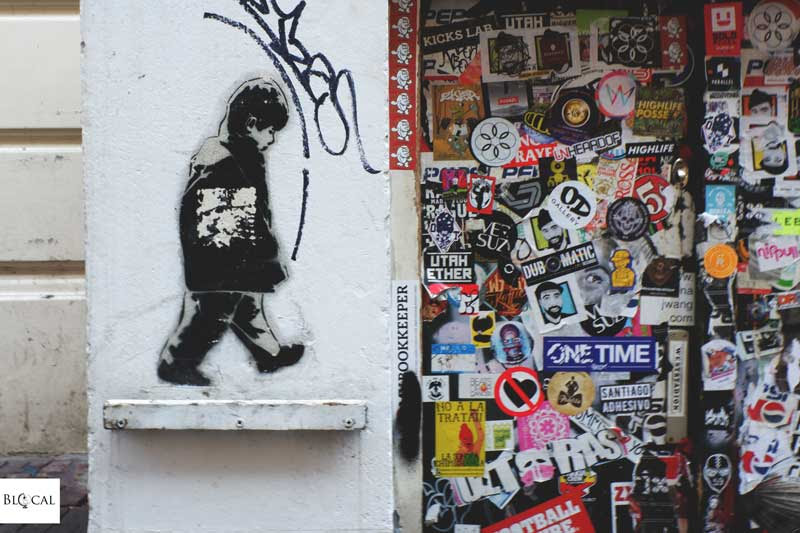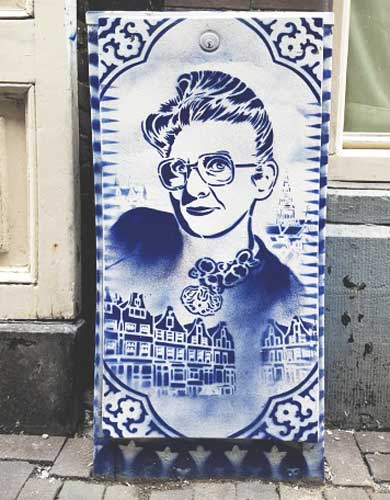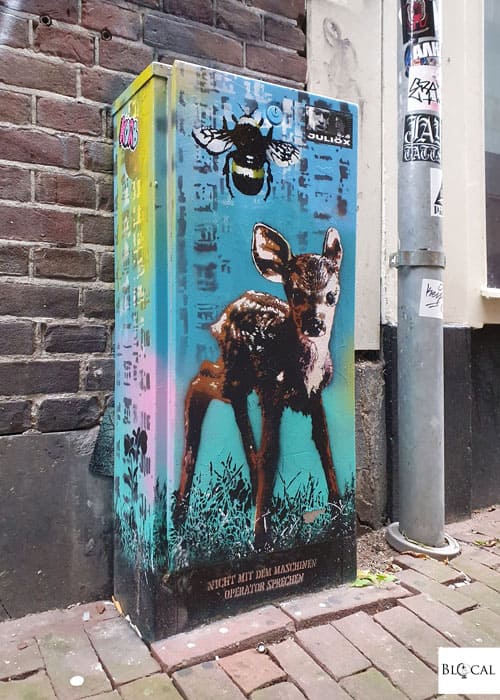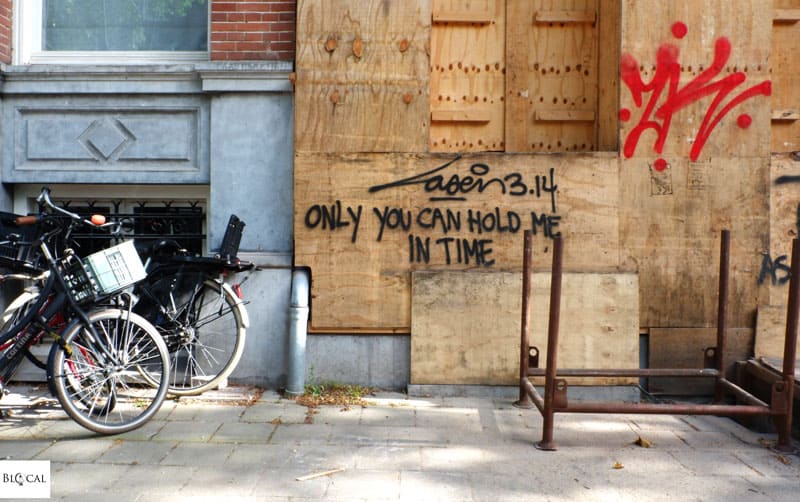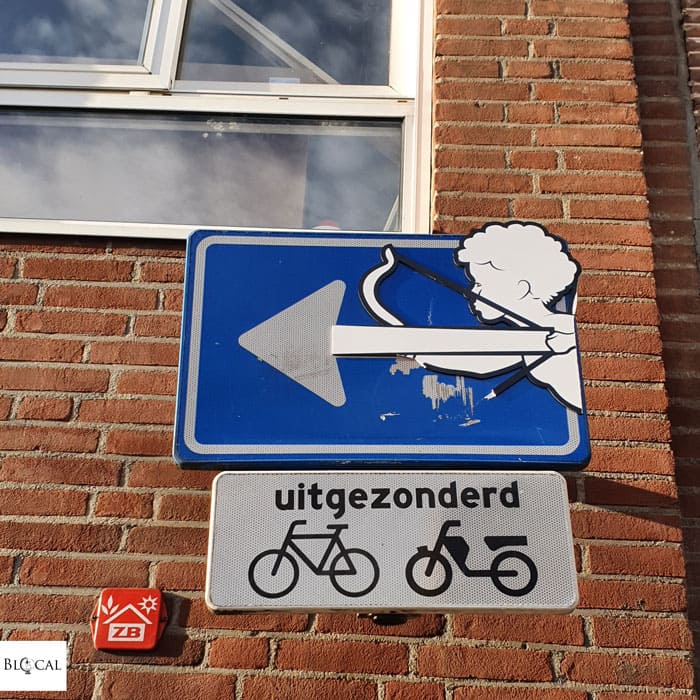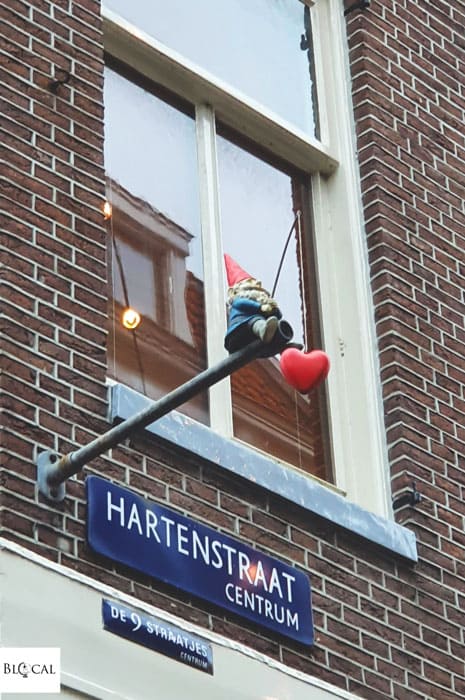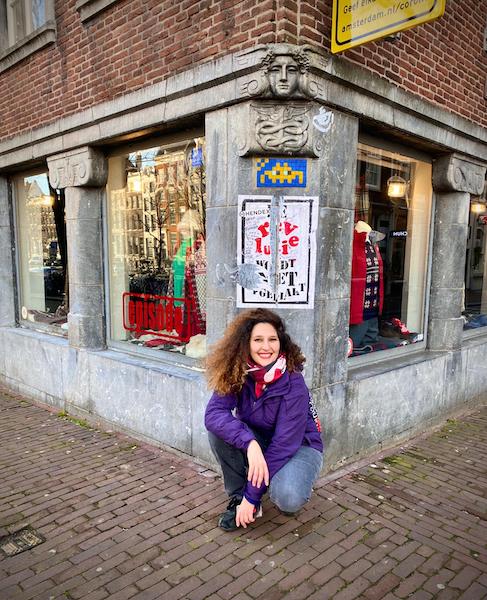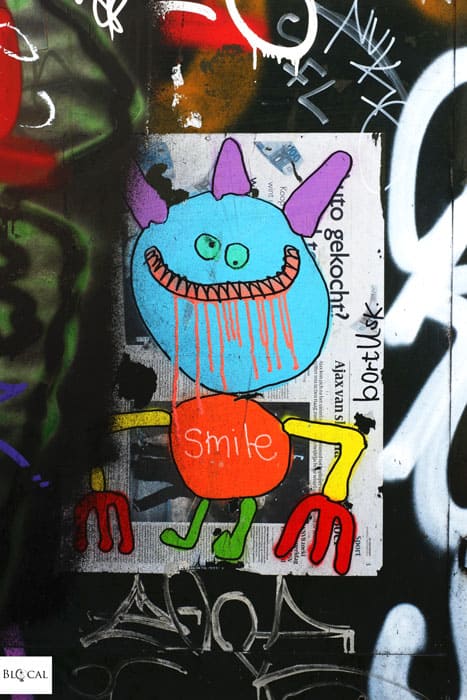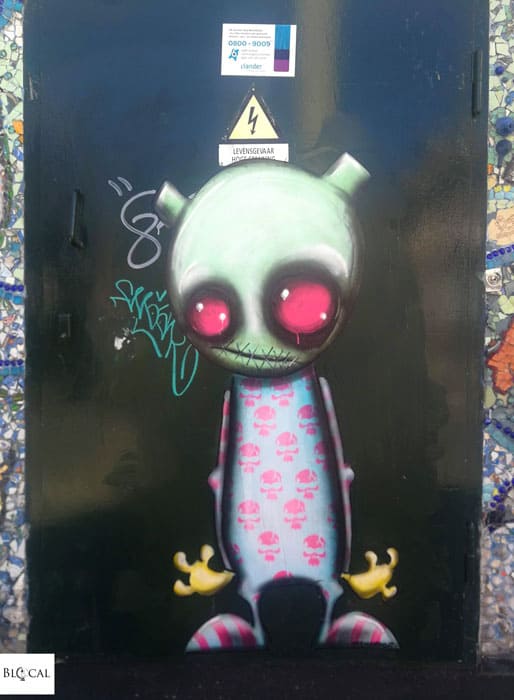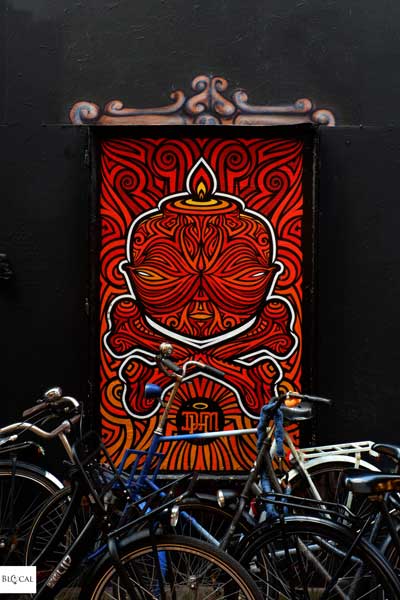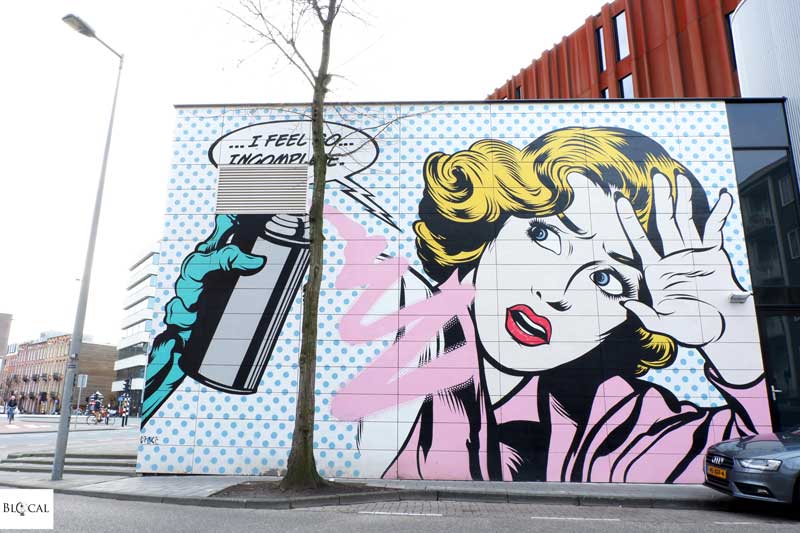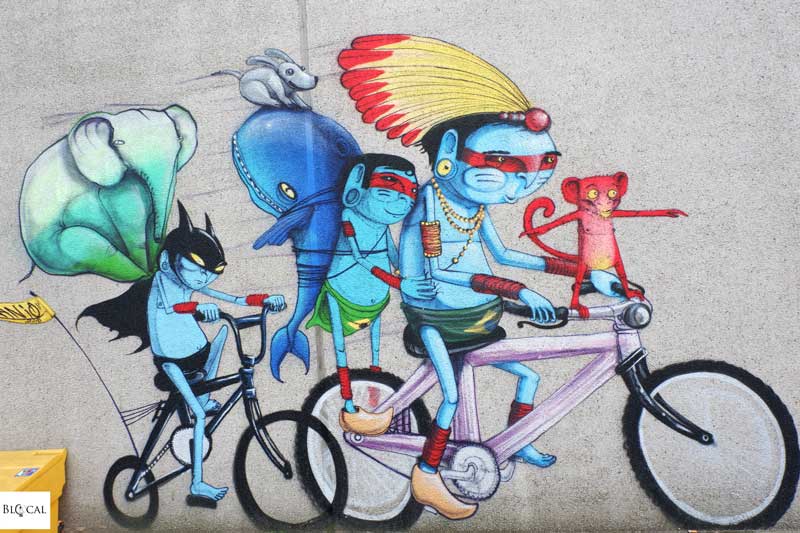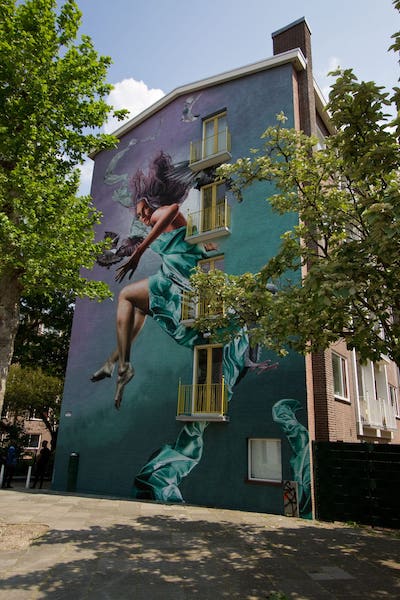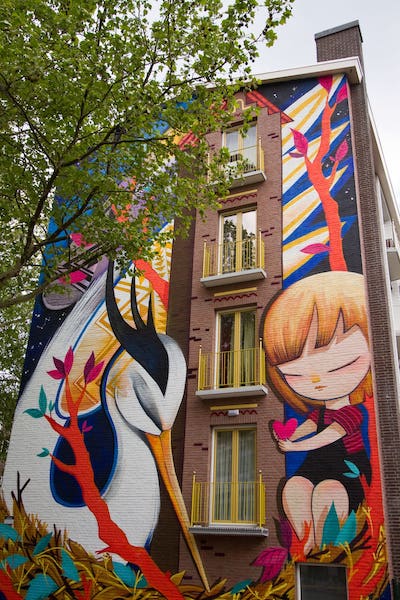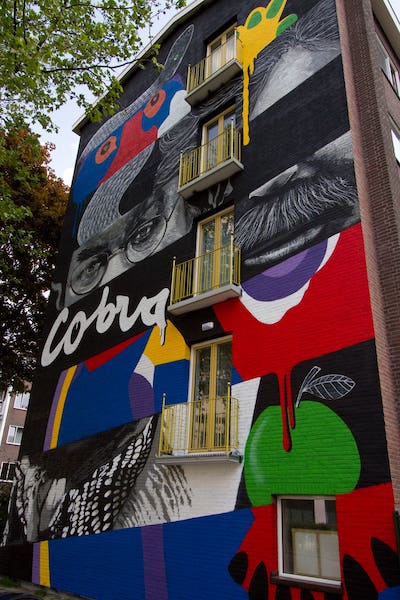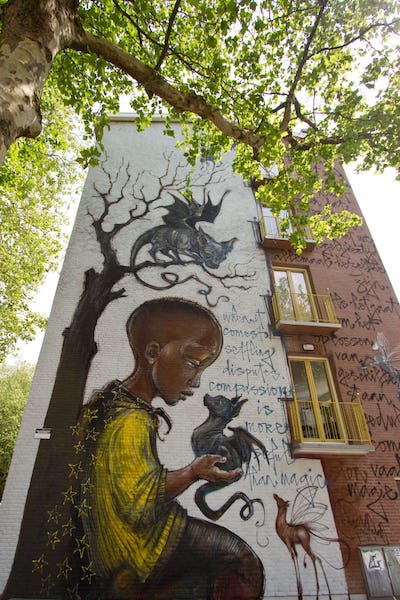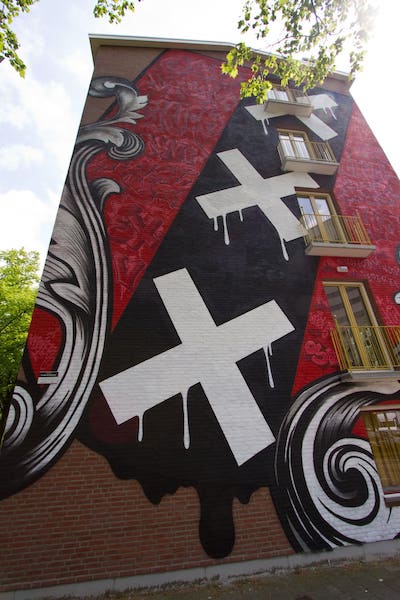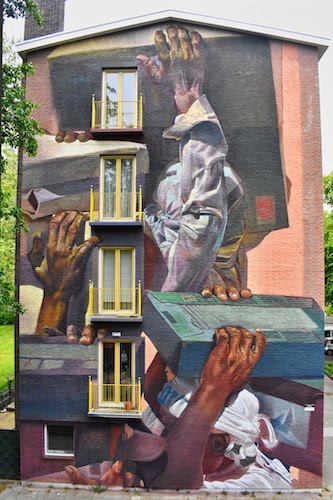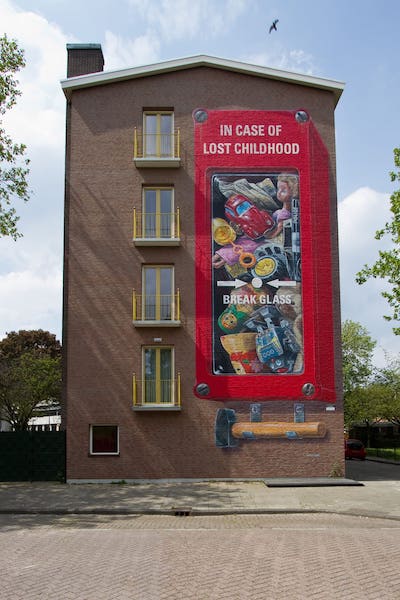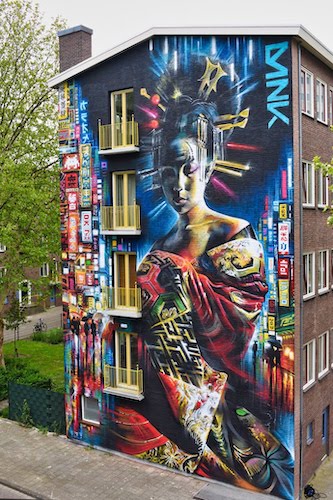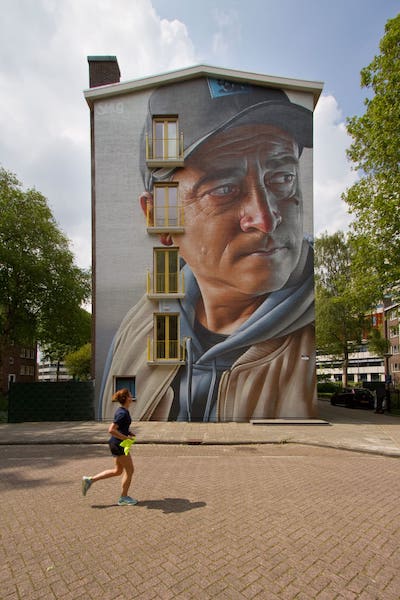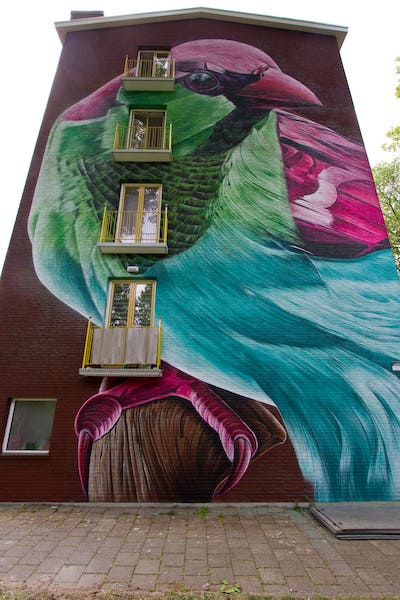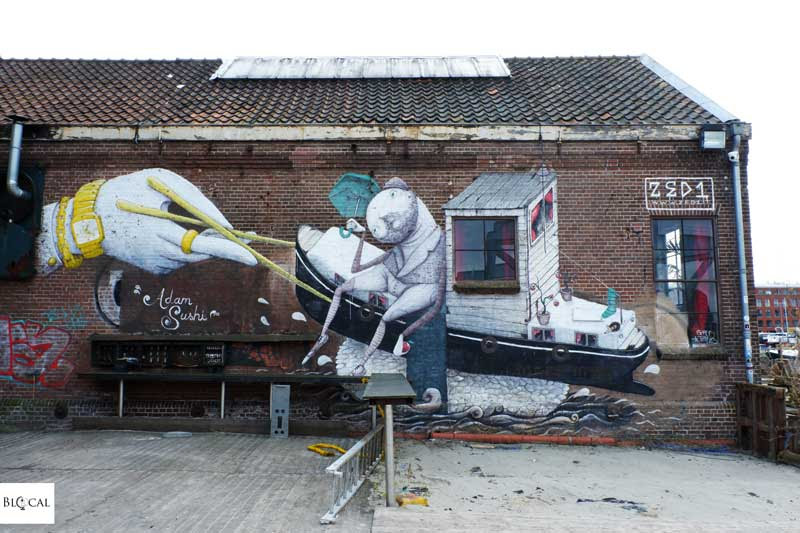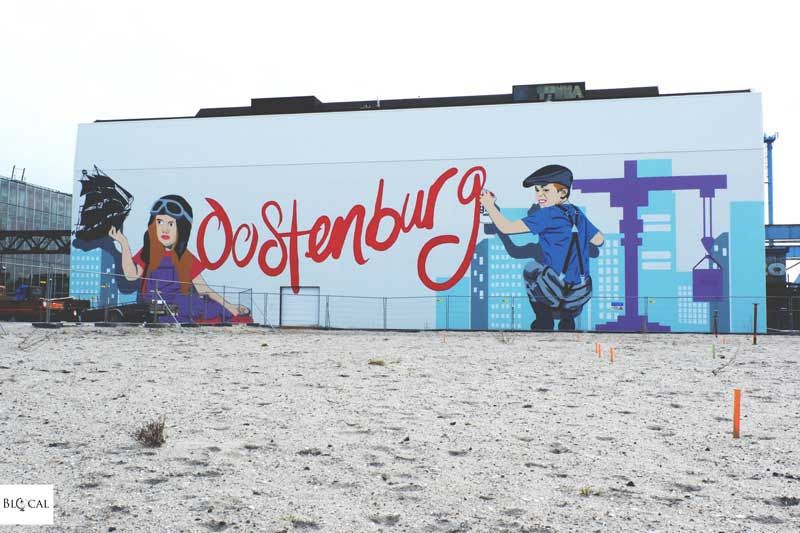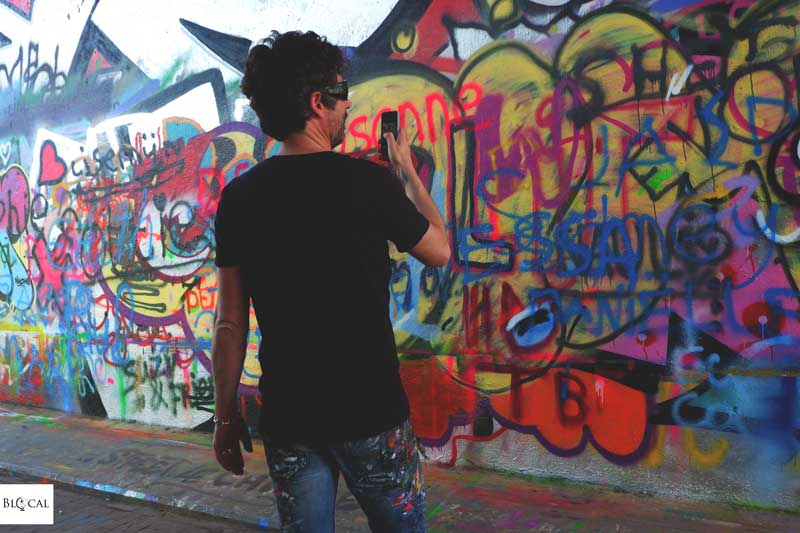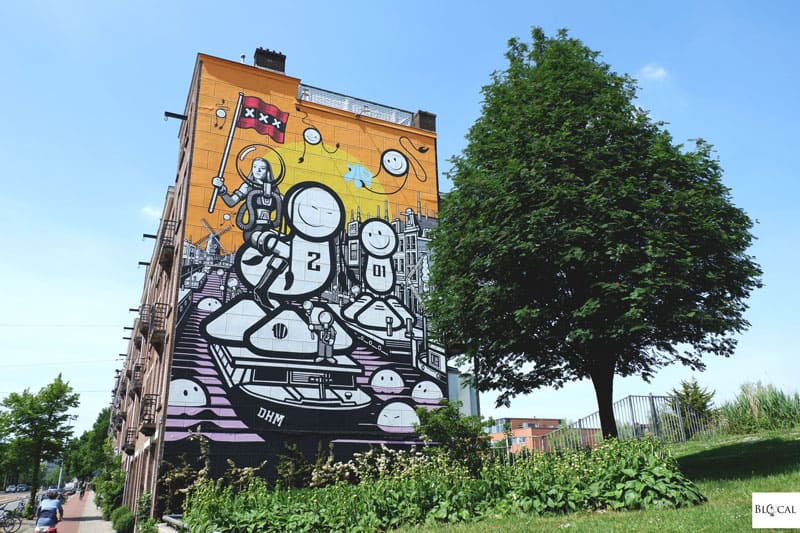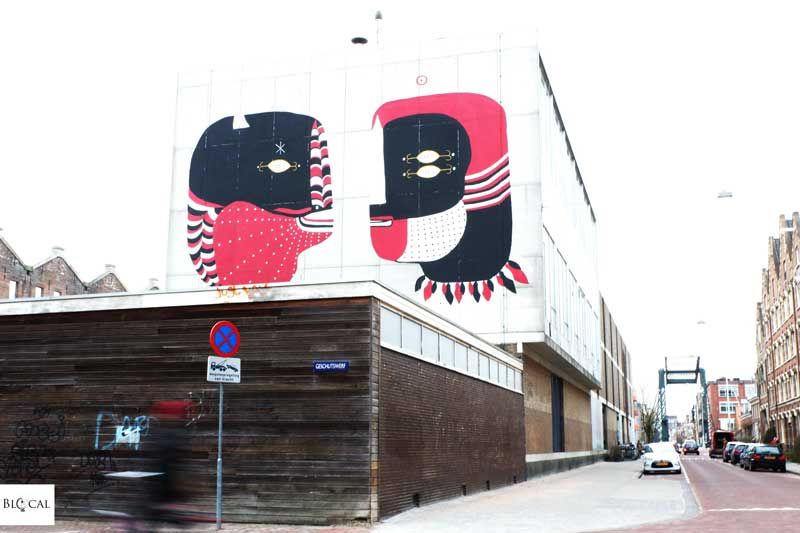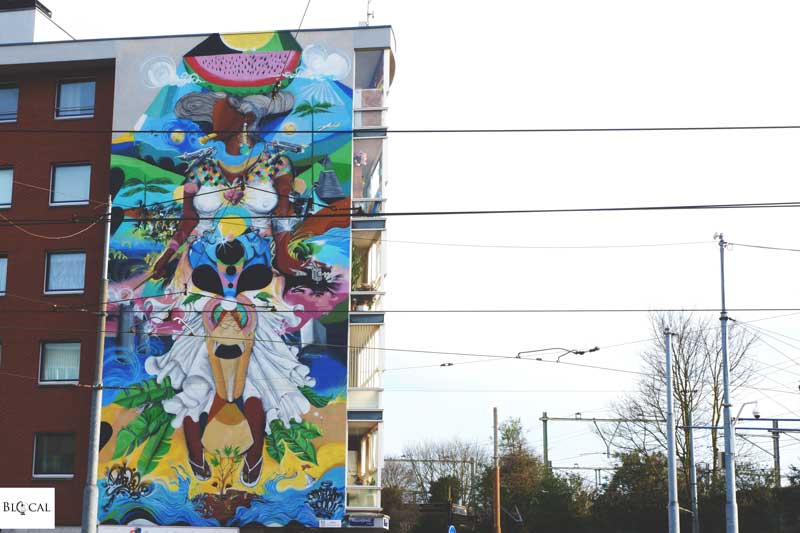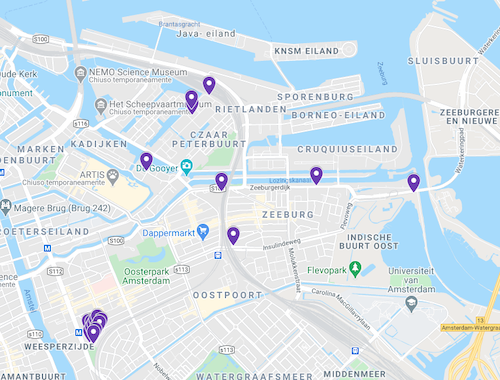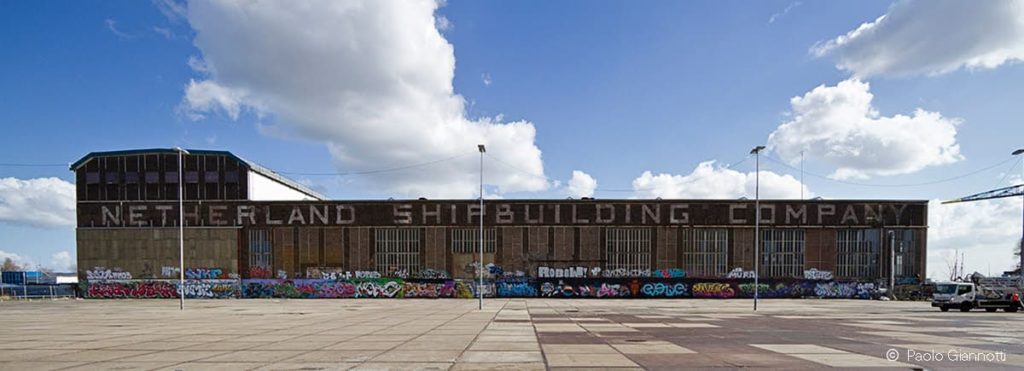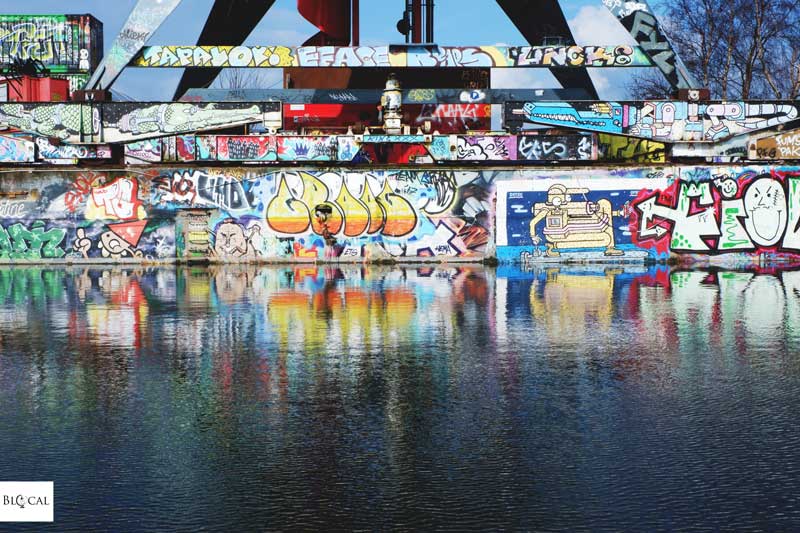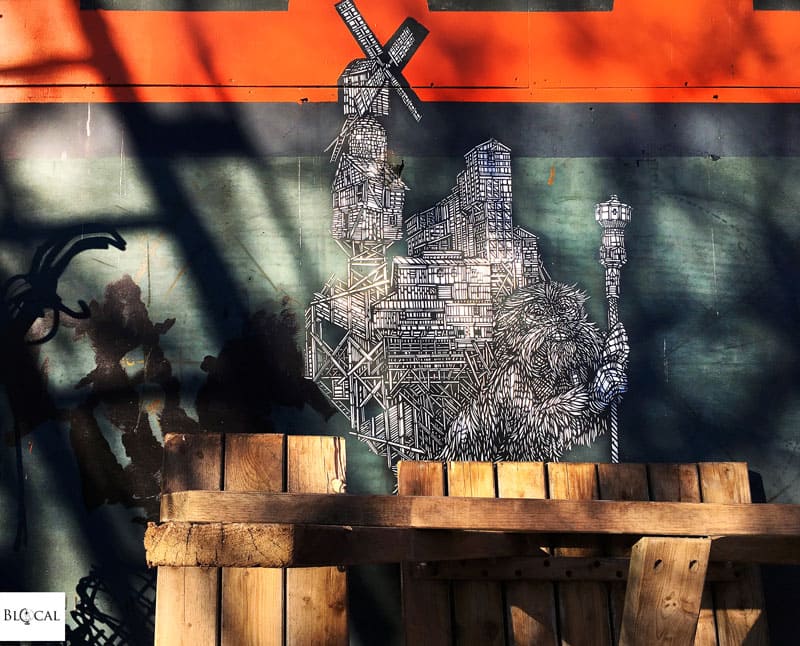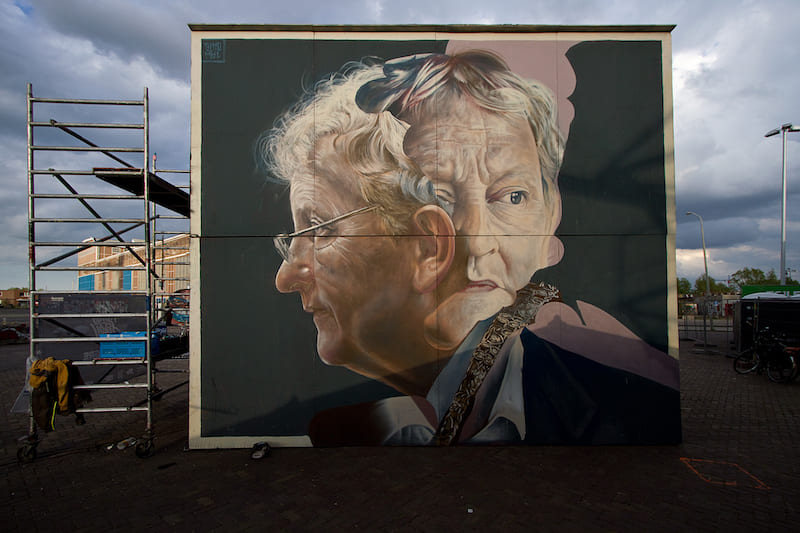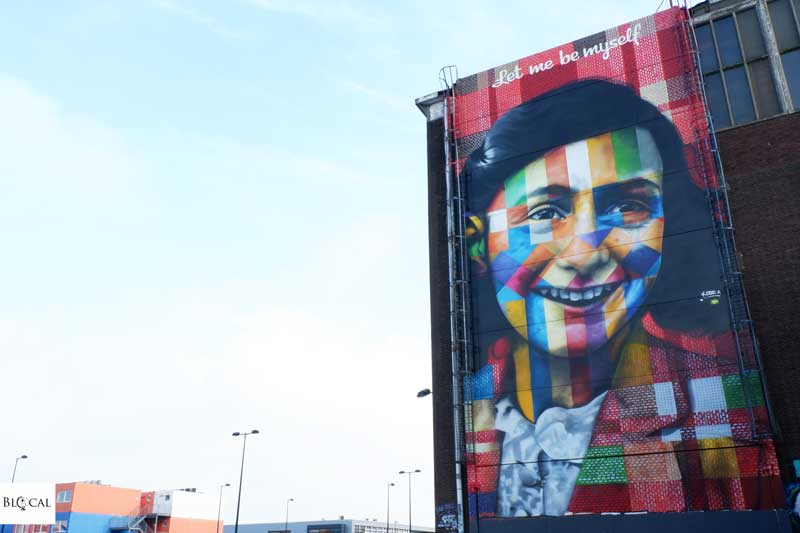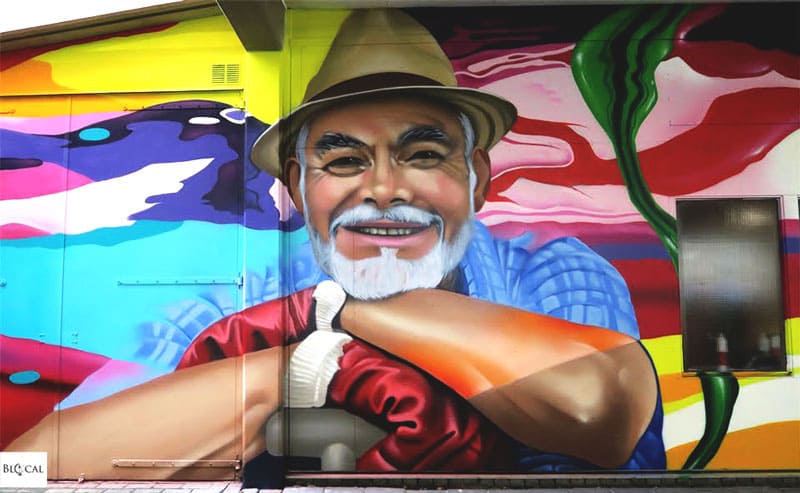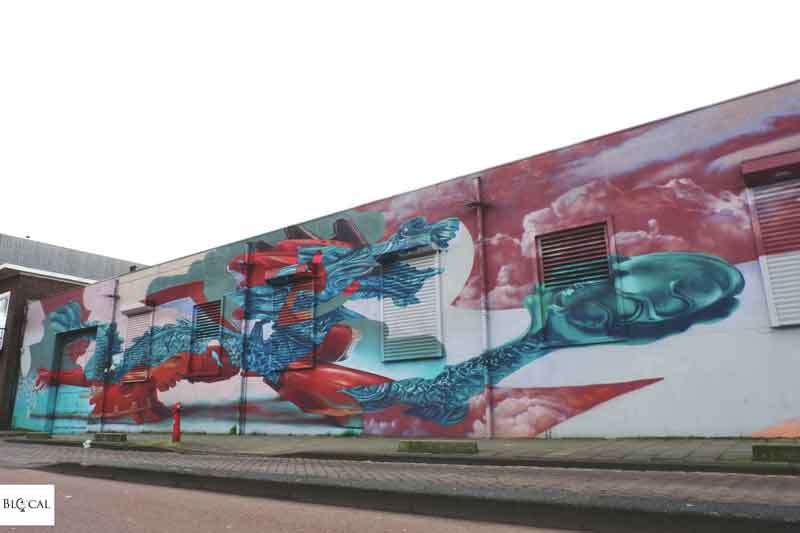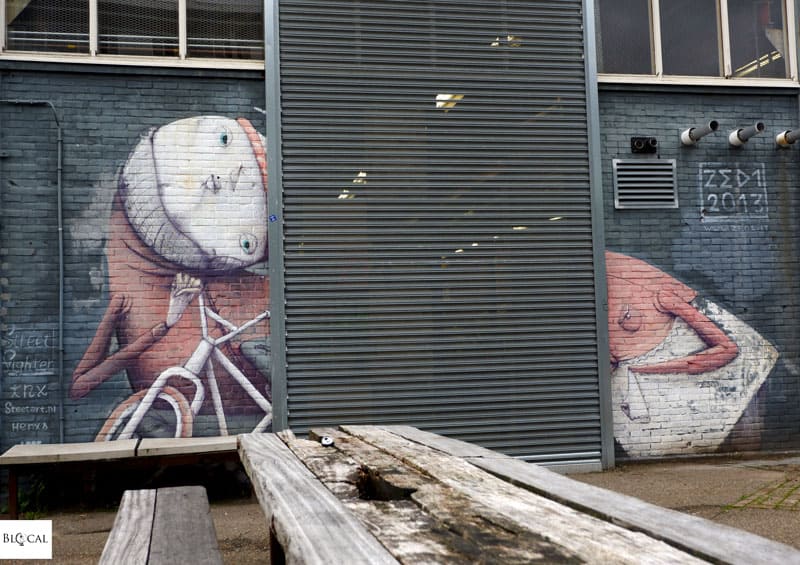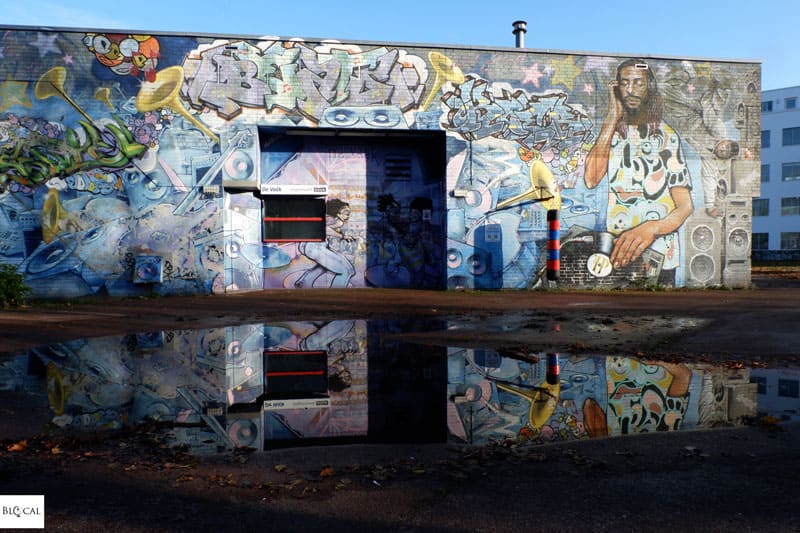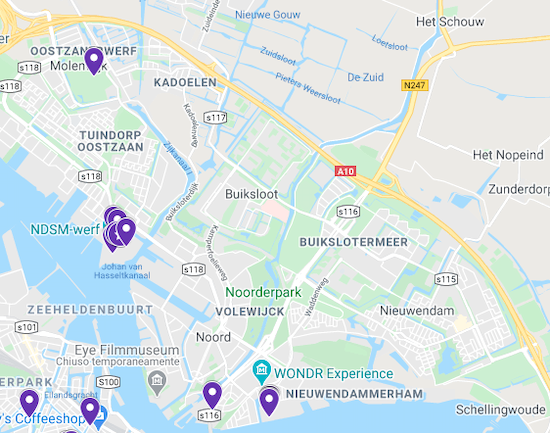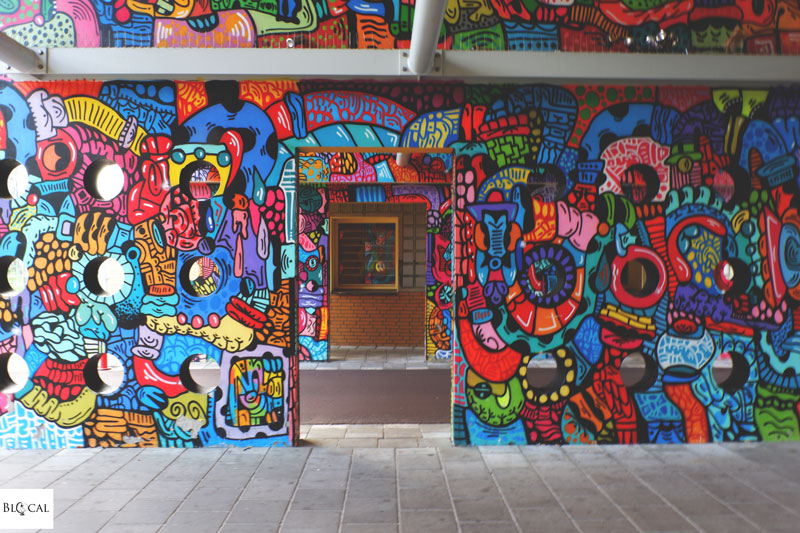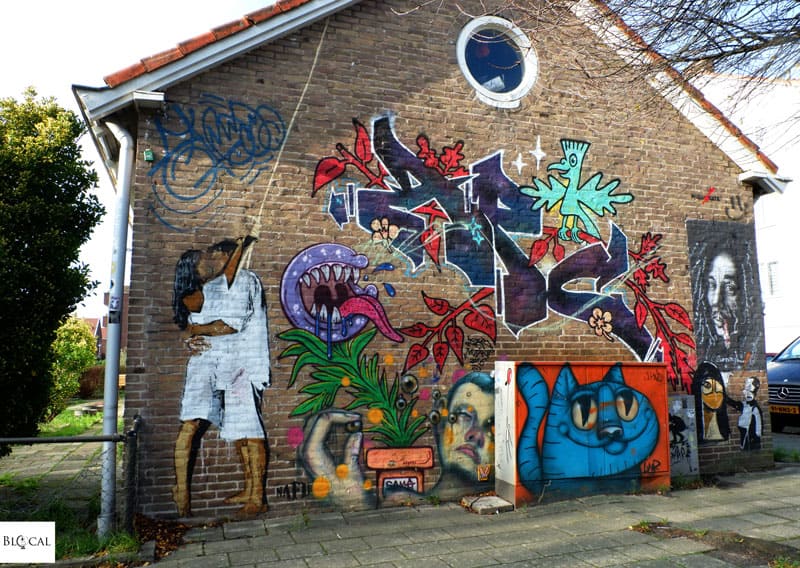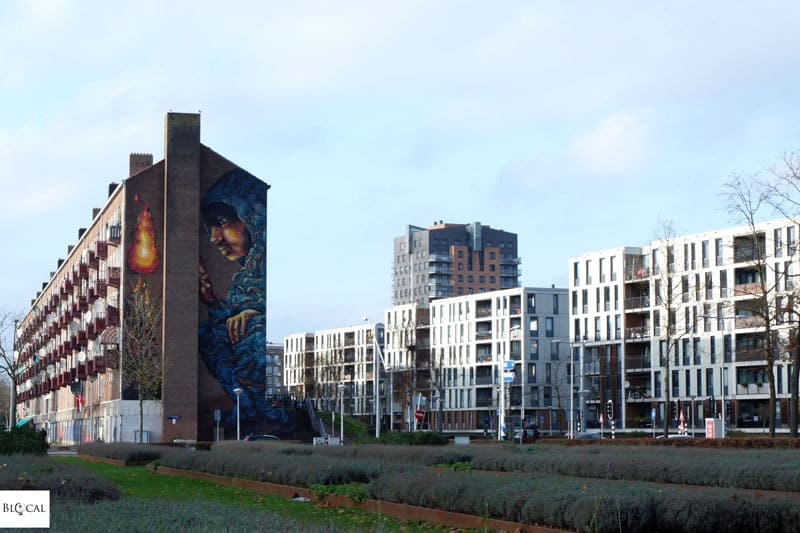I’ve always found it difficult to write about the city where I live in. This is why so far I’ve shared Amsterdam street art only on Instagram but, now that I live somewhere else, I could smoothly dive into my Amsterdam’s street art archive and write about graffiti and street art in Amsterdam, the city I called home for two and a half years.
Join me on the hunt for street art in Amsterdam!
History: A Short Introduction to Graffiti and Street Art in Amsterdam
It was 1984 when Dutch national TV broadcasted “Style Wars.” At the time, there were already tags from the early 1980s in Amsterdam, done mostly by hooligans and punks, but nothing related to hip hop.
Along with the movie “Style Wars,” another major event changed the game in the streets of Amsterdam. In 1983, Amsterdam gallery owner Yaki Kornblit organized the first solo show in Amsterdam boasting an NYC graffiti artist, Dondi. The Dondi exhibition was followed by nine other shows of old-school graffiti artists from New York at Yaki Kornblit’s gallery: Seen, Bill Blast, Blade, Crash, Zephyr, Quik, Daze, Rammellzee, and Futura 2000. The arrival of the Americans subverted the local scene, which until then was primarily made by punk rockers painting band names on the city walls using typography popularised by UK band albums.
After this pivotal moment and throughout the 90s, Dutch graffiti artists developed a bold, colorful style that was strongly influenced by the wildstyle overseas. However, in a country where people move on bikes, writers in Amsterdam were primarily bombing the streets and hitting trams and worker shacks. Representatives of this generation are: SHOE, DELTA, ZEDZ, RHYME, CAT22, SENDER, YALT, MATH, OASE, and MICKEY, one of the few female graffiti writers in all Europe.
The late 90s were also the dawn of the Amsterdam street art scene, pioneered by a multicultural community of artists in the likes of The London Police, Wayne Horse, Morcky, and Galo. Some of them shared a background in classic graffiti, while others embraced the street as the ultimate canvas on which they could create in total freedom. The name “street art” hadn’t been around yet, but there were many young artists out painting (many more than nowadays!) and they were all painting illegally. Painting for the sake of it, without even thinking about gallery shows and commissioned walls – let alone social media – was the essence of this young generation of Amsterdam’s independent public artists. Their voice in the streets was true artistic freedom.
- Read also: A series of interview retracing the birth of graffiti and street art in Amsterdam
Where to Find Street Art in Amsterdam (with map!)
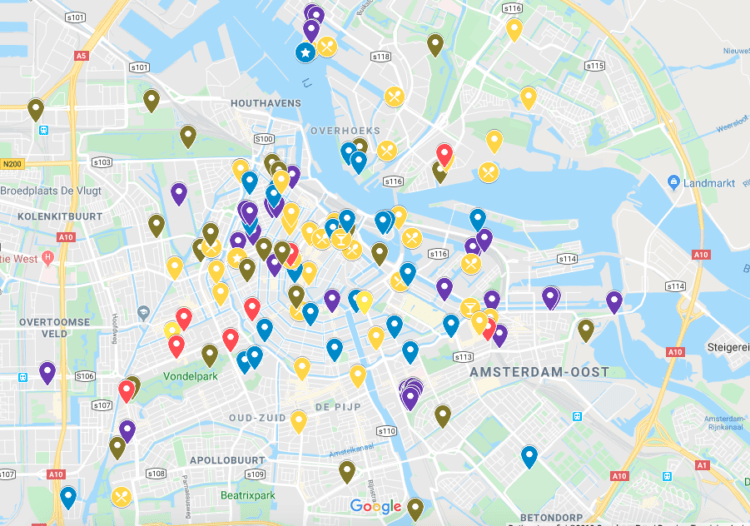
After that much-needed introduction, there is only one way I can carry on with this street art guide of Amsterdam. It’s not by writing about the graffiti and street art museum where I worked, nor is this done by telling you about the urban art project that kicked off a series of serendipitous events that brought me to live in The Netherlands, because my obsession with Keith Haring is louder than all that ;)
The Keith Haring Mural in Amsterdam
After his European debut in Rotterdam in 1983, Keith Haring was invited to Amsterdam for a solo show at the Stedelijk Museum. For this exhibition, Keith Haring, who often worked on unconventional surfaces, spray-painted a 20×12-meter woven canopy that filters daylight, which was hung beneath the museum’s glass ceiling. Such velum was exhibited again between 2017 and 2018 when, on my first ever trip to Amsterdam, I could admire how Haring’s bright colours flooded the museum hallway with a pastel-hued light.
Finally, Keith Haring painted a mural on a former warehouse in Amsterdam West, which back then housed the Stedelijk’s art storage depot. Today, however, this is part of Amsterdam’s Food Center. Depicting a sea monster with a figure on his back, this piece was done freehand with a brush and white paint, tracing a thick, unbroken line that must have been very hard to achieve on that porous brick wall. Next to his signature, Keith drew the three Andreas crosses that symbolize the city of Amsterdam.
For reasons of climate control, after a few years the painting was covered with sheets of weatherboarding, so it was no longer visible. It wasn’t until 2018 that a team of restorers could give this artwork back to the city. It goes without saying that I interpreted this event as Amsterdam getting ready for my upcoming arrival :)
The building is not open to the public; you can only enter Amsterdam’s Food Center with a special Horeca pass. However, you can still get a great picture of Keith Haring’s mural from the parking lot at the other side of the canal, whose exact location you can find in my Amsterdam Street Art Map:
Street art in the CITY CENTER of Amsterdam
With their monochromatic posters on almost every electric box in the city, The London Police pioneered Amsterdam’s street art movement, and so it makes sense that we start our street art hunt from their iconic mural on Prinsengracht. The painting features their ubiquitous LADs next to a self-portrait of the duo driving a bus, Chaz on the left and Bob on the right.
Another large-scale mural in the city center is the pop art “BOOM” on the facade of the building housing one of the very few squat places left in Amsterdam: the Vrankrijk. In the past, this street (Spuistraat) was fully covered with graffiti and spontaneous street art, including a very famous, five-storey mural from 1987 depicting a psychedelic snake.
Clearly inspired by Dutch old masters is the small mural by the local duo Telmo Miel, well known around the world for their realistic style.
Just around the corner you’ll find a shutter painted by Inkie, who emerged from the 1980s Bristol graffiti scene alongside Banksy. Inkie painted one of his iconic women, who are inspired by the Art Nouveau movement.
Next to it, an old piece by Bustart, Zaira and Anopsy, three artists that used to be very active in the streets of Amsterdam in the good ol’ days. If Bustart and Zaira are no longer living in Amsterdam, Anopsy kind of went under the radar, meaning that she now paints at the Flevopark Hall of Fame, at the Zaandam skatepark, and at other “unglamorous” spots to keep her figurative graffiti authentic.
More spontaneous pieces have been left behind by visiting artists through the years, such as the French stencil artist Goin and the Iranian brothers Icy & Sot, who began stencilling in the streets of Tehran in the 90s and, since 2012, live as political refugees in Brooklyn.
Now let’s talk about electric boxes, which we saw were a thing in the development of Amsterdam street art movement. A contemporary take on such mediums are the interventions on St. Jansstraat and Dirk van Hasseltssteeg, respectively by Hugo Kaagman and Pipsqueak Was Here.
Hugo Kaagman was active throughout Amsterdam’s punk movement, at the dawn of the Dutch graffiti and street art scenes. He created punk zines and used stencils to spray political messages. Today, his pieces are mostly painted in blue and white, evoking traditional Dutch Delftware.
Pipsqueak Was Here is a Dutch duo painting the relationship between men and nature. Their meaningful observations on how the urban environment is prevailing onto the animal kingdom are never undermined by their colorful and playful approach.
Wandering around the city center of Amsterdam, you will surely stumble upon Laser 3.14’s street poems. They are very recognizable: the tag is always on top of a sharp statement usually written with black spray paint, in a very clear calligraphy, and always in English. The Dutch artist does so not only to be more inclusive, but also because he listens to a lot of rap music in English and so when he tried to write his poems in Dutch they somehow didn’t feel right.
Laser 3.14 always writes on wooden panels, the ones that are found around construction sites, because he likes the idea that his pieces are temporary. It’s his way of taking his city back, a city that is changing super fast and -indeed- these construction panels are the most visible symbol of all these changes undergoing around Amsterdam.
Read also: Interview with Dutch street artist and street poet Laser 3.14
Another Dutch artist whose interventions you’ll find scattered throughout the Amsterdam city center is Street Art Frankey. Frankey’s artworks are humorous and fun, usually without any political or social message, they just play with street furniture or the urban landscape around them.
Less numerous in the streets of Amsterdam (sadly, because they have been stolen) are the mosaic tiles by Space Invader, a well-known street artist from France who has been active since the 90s. His mosaics are inspired by the first generation of video games and their subversive power lies in the decontextualization of an artform traditionally associated with the opulent interiors of palaces and mansions.
As for poster art, the most active poster artist in Amsterdam is undoubtedly Bortusk Leer. His happy, brightly coloured monsters are painted in a childish style, often on newspaper pasted on the walls, in psychedelic neon colours to properly brighten up the passer-by’s day.
Fascinated by children’s spontaneity, Bortusk Leer’s philosophy is epitomised by his slogan: “Cheer Up You Bastards.”
Another poster artist who is ubiquitous on Amsterdam’s walls is Stenandoli. Active since 1999, his posters feature melancholic characters painted with a romantic watercolor effect.
Before leaving the city center, let’s stop at Café Belgique, the tiny pub where Amsterdam’s street artists hang out. If you’re lucky, you can catch The London Police playing vinyls behind the bar ;)
The exterior of the pub has seen over time a continuous succession of original artworks painted by local and international street artists, a project curated by The London Police’s Chaz himself.
Street art guide of Amsterdam OOST
Unlike the city center, the Eastern part of Amsterdam is an area where you can find many large-scale murals. Our hunt starts at The Student Hotel, which is just above the metro station Wibaustraat. Street artists in the likes of D*Face, Cranio, Bustart, Niels Westergard, The London Police and Jaune have left a piece both outside and inside the building, which is not only a hotel but also a co-working space, bar, and event space.
Opposite this trendy location are ten large-scale murals created for “If Walls Could Speak”, a festival curated by my friends at ASA (Amsterdam Street Art) in Spring 2019.
Coming from the metro station, the first mural in view is the one by Dutch realism masters Kaspar van Leek and Niels van Swaemen, who work together under the name Studio Giftig. Their floating woman is blending with pigeons, which symbolizes both freedom and the city of Amsterdam.
Up next, Spanish artist Julieta XLF painted her iconic “niña” (girl). This female character, which is the protagonist of all her artworks, is naive yet conscious of the natural world around her.
On the wall that follows, Sjem Bakkus and Ives One realized a multi-layered portrait of Karel Appel, who was born in this neighborhood. They wanted to tribute the Cobra avant-garde Movement, which consisted of artists from Copenhagen, Brussels and Amsterdam working on experimental art.
Hera, from the German duo Herakut, painted one of her strong expressive figures. The sentence written in her typical scratched calligraphy says “When it comes to settling disputes, patience and compassion are often more useful than magic.”
Graffiti artists KASH and Chuck painted their interpretation of Amsterdam’s coat of arms. The three crosses in it refer to the three dangers medieval Amsterdam faced: fire, floods, and the Black Death. The title of the mural is “Het Wapen van Verbroedering” (The Weapon of Fraternization).
Five more murals are at the other sides of these buildings. German artist Case Maclaim painted one of his recurring subjects – hands – using the unique colour palette of the area. The title of the artwork is “Carrying Belongings.”
Leon Keer invites us to reconnect with our inner child via an outstanding anamorphic piece featuring a box of old toys. The mural is a reminder for every adult that we are still free to do whatever we want.
Dan Kitchener gifted Amsterdam with one of his iconic, brightly coloured geishas contemplating a rainy street scene crowded with neon signs. DANK’s murals are about the beauty of the light that is always emerging from the darkness.
Australian muralist Smug painted the portrait of a friend in his classic photorealistic style. The title of the piece is “Beter een goede buur dan een verre vriend.” (A good neighbor is better than a distant friend.)
Finally, Dutch artist Dopie put up one of his bright colored animals. The feathers of this parrot (namely: the rose-ringed parakeet) now illuminate the area through countless shades of vivid hues.
Another street art spot in the Eastern part of Amsterdam is Roest, a creative bar where Max Zorn organized the ‘Stick Together’ festival and where local graffiti writers organized several paint jams throughout the years. It goes without saying that this narrow land between the canal and the railroad tracks is full of pieces, most notably a very old piece by Italian artist Zed1, a piece by Niels Westergard and a huge mural by ASA, which is a tribute to this industrial area in between maritime heritage and future development.
Oost is also home to Amsterdam’s most authentic Hall of Fame (a place where walls can be painted legally), which is inside Flevopark.
Not too far from it, there is the mural by The London Police that has unwillingly become the image of my “Amsterdream”. The first time I saw it was after my job interview for the museum and on the mural was a sign (prophetically, in my head) stating “to be continued”…
Two more big murals worth seeing in Amsterdam Oost are by two Brazilian artists: Fefe Talavera, whose colorful monsters represent Brazilian Indians wearing animal masks as part of a local protest against big utility companies, and Diego Dedablio, whose colorful woman explores the connection between this multicultural area and the artist’s home country.
Where to find street art in Amsterdam Oost > Amsterdam street art map:
Street art guide of Amsterdam NOORD
I’m writing about my love for NDSM since my first trip to Amsterdam. All around this colorful wharf, which used to be the largest shipyard in Europe, you can now find loads of graffiti and spontaneous street art.
The area was colonized by artists and creative people of all kinds in the 2000s, when the city council evicted most of the squats downtown. They established their studios inside the former shipbuilding hall and under the slipways, which is where you will find most of the street art pieces.
Still, at NDSM you will spot many pieces painted on towers made of ship containers. The first one to appear was a tribute to Amsterdam’s former mayor Eberhard van der Laan, who sadly passed away in 2017, painted by Dutch duo Telmo Miel.
More containers were painted during Kings Spray 2019, a graffiti and street art festival held on the day of the birthday of the King at the NDSM wharf. I was both the communication manager and artist manager of the festival and I had the honor of working alongside a true graffiti king, New York City’s BLADE, as well as many other artists. But you guys already know that story, right?
NDSM is also home to a very popular Hall of Fame, which runs all around the huge warehouse that hosts the graffiti and street art museum STRAAT, where I worked in the two and a half years leading to the opening.
Next to the entrance of the museum, you’ll spot the most iconic mural of Amsterdam: a kaleidoscopic portrait of Anne Frank painted by the acclaimed Brazilian artist Eduardo Kobra in 2016.
However, the supreme beauty of Noord goes beyond the alternative vibe of NDSM. All around Amsterdam Noord there are several more murals worth seeing; for example, the colorful piece by the Dutch duo Karski & Beyond in a parking lot in Molenwijk, or an old piece by Telmo Miel depicting a dragon.
More pieces are in the area where the Urban Art Fair took place in 2019, by my friend Potato Nose from Libanon, by Bustart from Swiss, or by the Dutch duo Pipsqueak Was Here. They added up to an already colorful corner, where a very old piece by Zed1 is still shown off next to a piece by Dutch artist DHM.
For graffiti lovers, an unmissable stop in Amsterdam Noord is the youth center De Valk, where a massive paint jam (the Kosmopolite Art Tour) took place in 2009 with artists in the likes of Juice, Beast, the Belgian crew Farm Prod, Mac and Lazoo from France, and many more.
Where to find street art in Amsterdam Noord > Amsterdam street art map:
Where to find street art in the OUTSKIRTS of Amsterdam
This Amsterdam Street Art Guide is already too long without me repeating my love for the stunning murals produced by the RUA project in the Bullewijk area. It goes without saying that Zuid-Oost will always be my go-to recommendation for people who want to explore an outstanding mural collection and discover a different side of Amsterdam.
Another region known for its murals is Niew-West. This is the area of SAMA (which stands for Street Art Museum Amsterdam). On Google Maps I could only find the location of the project’s HQs, which indeed is fully covered with street art.
However, my luck ended there and, eventually, I gave up and took the tram back to the city. I couldn’t find any mural except for the one by Hier on Colijnstraat as well as a funny installation by French artist Oak Oak.
I’m pretty sure many of those murals, which were produced back in 2012, have been torn down, because I could see that the whole neighborhood is under renovation, but maybe there are still some artworks around, which I couldn’t find… Let me know if you spot some!
Still, in Niew-West the Kallenbach Gallery recently produced four murals along the Wiltzanghlaan whose concepts are inspired by the stories that the four artists (Iriée Zamblé, Floor van het Nederend, Said Kinos and Sidney Waerts) collected from residents in the neighborhood. It was during a new lockdown in The Netherlands and the time I was packing and shipping all my belongings to Italy, so unfortunately I couldn’t be on-site during the mural’s production. But that’s just one more reason to visit Amsterdam again!
